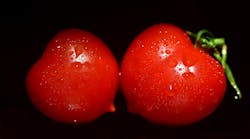As LED lights gain acclaim in horticultural circles for allowing growers to finely tune spectra and brightness for year-round optimal growth and low energy consumption, one might stop to wonder: Are the fruits and vegetables as tasty as when grown under other light sources?
One tomato grower in Germany asked exactly that question regarding LED lights versus conventional high-pressure sodium (HPS) grow lights. Bayern-based Gemüsebau Steiner has been using the two technologies side by side at its greenhouse in Kirchweidach, having recently replaced 1000 of its HPS lights with LEDs at the 20,000m2 facility. The LEDs cover 5000m2, while the HPS lights continue to shine over 15,000m2.
After sampling the fruits of both, Gemüsebau delivered its own answer: LED-raised tomatoes are tastier than their HPS brethren.
“In my opinion, the taste was better under LED than HPS,” head grower Andrei Mihai said in an interview with London-based Hyperion Grow Lights.
Full disclosure: Hyperion was the LED provider to Gemüsebau, so there’s clearly some self interest in Hyperion posting the news on its website.
But the surprising part of the taste-test triumph for LEDs was that the tomatoes Gemüsebau grew actually had a lower “Brix” content under LEDs than under HPS. Brix is a measurement of sugar — in this case, natural sugar. A higher Brix level is typically associated with a sweeter and more flavorful product.
“It was warmer under the HPS lamps, therefore the fruits had higher temperature, resulting in slightly higher Brix level,” Mihai said. “However, in my opinion, the taste was better under LED than HPS; therefore, Brix level is not the key measure. Our customers judge the quality of tomatoes on taste rather than on Brix level; therefore, our main objective is to get the taste right.”
The interview did not delve into the other factors behind flavor, which LEDs Magazine and its contributors have written about with regard to the ability to influence the composition of secondary metabolites and flavonoids in fruits and vegetables by using customized horticultural lighting spectra, in some cases with ultraviolet (UV) wavelengths.
Nonetheless, it leaves no doubt that Gemüsebau is impressed with its LEDs, which Mihai said delivered higher yields as well as bigger, stronger, and more “generative” tomatoes than HPS. The interview stopped short of quantifying many of the differences, although Mihai did say that the LEDs saved 40% on energy consumption, which was slightly more than Gemüsebau had originally anticipated.
This is not the first time that Hyperion — formerly part of Plessey Semiconductors — has compared LEDs to HPS on the site of a large grower. Last year at Tomato Masters in Deinze, Belgium, it addressed concerns that the lack of heat from LEDs might undermine tomato quality. In that case, Tomato Masters engineered some heat retention measures into its LED-equipped greenhouse that it would not normally use with HPS lights.
MARK HALPER is a contributing editor for LEDs Magazine, and an energy, technology, and business journalist ([email protected]m).
For up-to-the-minute LED and SSL updates, why not follow us on Twitter? You’ll find curated content and commentary, as well as information on industry events, webcasts, and surveys on our LinkedIn Company Page and our Facebook page.

Mark Halper | Contributing Editor, LEDs Magazine, and Business/Energy/Technology Journalist
Mark Halper is a freelance business, technology, and science journalist who covers everything from media moguls to subatomic particles. Halper has written from locations around the world for TIME Magazine, Fortune, Forbes, the New York Times, the Financial Times, the Guardian, CBS, Wired, and many others. A US citizen living in Britain, he cut his journalism teeth cutting and pasting copy for an English-language daily newspaper in Mexico City. Halper has a BA in history from Cornell University.





